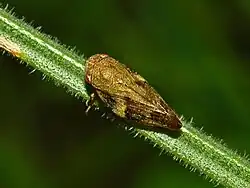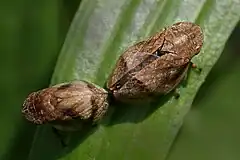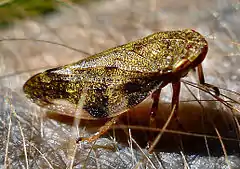| Aphrophora alni | |
|---|---|
 | |
| Aphrophora alni, side view | |
| Scientific classification | |
| Domain: | Eukaryota |
| Kingdom: | Animalia |
| Phylum: | Arthropoda |
| Class: | Insecta |
| Order: | Hemiptera |
| Suborder: | Auchenorrhyncha |
| Family: | Aphrophoridae |
| Genus: | Aphrophora |
| Species: | A. alni |
| Binomial name | |
| Aphrophora alni (Fallén, 1805) | |
| Synonyms | |
| |
Aphrophora alni, the European alder spittle bug, is a species belonging to the family Aphrophoridae.
Distribution
This species is quite common and widespread.[1] It is present in most of Europe, in the eastern Palearctic realm, in the Near East, and in North Africa.[2] It is naturalized in North America.[3]
Habitat
These 'froghoppers' inhabit dry and moist habitats of lowlands and mountainous areas, forest edges, hedgerows, meadows, gardens and parks, from the lowlands up to mountains at an elevation up to 1,500 metres (4,900 ft) above sea level.[4]
Description

The adults of these large 'froghoppers' reach 9–10 millimetres (0.35–0.39 in) of length,[1] the females are usually slightly larger than the males. The basic coloration of the body is usually brown. Their front wings wear two distinct clear patches on the margins.[1] Head and pronotum have a median keel.[1] The head has a pair of compound eyes and two simple eyes (ocelli). The legs are strongly developed and fit to jump. Tibiae of the rear pair of legs carry several spines.[5][6]
Biology
They can be encountered from May through October[1] on bushes and on several species of trees, especially willows (Salix species), birch (Betula species), alder (Alnus species) and poplar (Populus species).). Aphrophora alni is a polyphagous species, meaning it feeds on several kind of plants. The adults primarily feed on deciduous trees, while larvae prefer herbaceous plants (dicotyledonous).[4][7]
To lay eggs, the females migrate to the herb layers. The eggs overwinter and hatch the larvae in the following spring. The larvae live in stems and leaves of herbaceous plants inside the typical foam nest, that protects them against enemies and provide necessary moisture and temperature for their development. Aphrophora alni has only one generation a year.
Gallery
 Mating
Mating

- Clip
References
- 1 2 3 4 5 British Bugs
- ↑ Fauna europaea
- ↑ Andrew Hamilton: The Spittlebuqs of Canada (Homoptera, Cercopidae). The Insects and Arachnids of Canada, Part 10. Biosystematics Research Institute, Ottawa, Ontario, Research Branch Agriculture Canada, Publication 1740. Ottawa 1982.
- 1 2 H. Nickel: The leafhoppers and planthoppers of Germany (Hemiptera, Auchenorrhyncha): Patterns and strategies in a highly diverse group of phytophagous insects. Pensoft, Sofia and Moskau, 2003, ISBN 954-642-169-3
- ↑ Walter J. Le Quesne: Handbooks for the identification of British Insects. Vol. II. part 2 (a). Hemiptera. Cicadomorpha (excluding Deltocephalinae and Typhlocybinae). Londyn: Royal Entomological Society of London, 1965, s. 8-11.
- ↑ Bob Gibbons FIELD GUIDE TO INSECTS OF BRITAIN AND NORTHERN EUROPE
- ↑ Commanster
External links
- Biolib
- Aphrophora
- ITIS Report
- Soulier-Perkins, A. (2013) Cercopoidea Organised On Line.